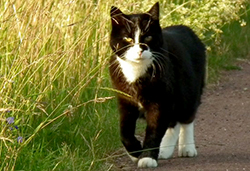CatRescue 901 is a small team of volunteers who are dedicated to helping cats in need in pounds and the community. We do not receive any funding and are only able to continue our vital rescue work thanks to the generosity of the community. Donations over $2 are tax deductible. Thank you for your support.
 12 things to do when your pet has gone missing:
12 things to do when your pet has gone missing:
1. Cats can smell familiar scents up to one kilometre away so:
(a) Put your cat’s used (dirty) kitty litter outside after removing solids.
(b) Put cat’s used bedding and your own last worn clothes and bed sheets on the clothes line
(c) Keep putting food out for your pet morning and night. If close, he/she may eat it when noone is watching and it is another familiar smell to encourage him home or to stay close by.
2. Create a poster very urgently, put it in upside down plastic sleeves on telegraph poles. Click to download a lost pet poster template.
3. Ring vets in your suburb and areas close by to inform them and ask if they would put a poster up for you.
4. Ring your local council straight away and ensure your microchip information is up to date and ask them to list the pet as missing. Remember to also let them know as soon as your pet is found. Or you can do this online yourself at the Companion Animals Register.
5. Contact lost animal pages on Facebook. The Australian Rescue and Rehoming Service website has an extensive list of Facebook pages. Many pets are reunited with owners as a result of Facebook lost and found pages.
6. List your lost pet with an agency. Agencies can be expensive but may improve your chances of finding your pet.
- Pet Search (phone: 1300 309 004)
- Where Pets are Found
- Lost Pet Finders (phone: 1300 725 640)
7. Drop flyers in letterboxes. Each day extend letter box dropping and poster coverage to a wider area.
8. Visit all your neighbours, give them a poster and ask them to check garages and outbuildings:
- We know of one cat who was locked in a garage for three weeks when neighbours went on holidays. She survived so there must have been some water available.
- A while ago someone opened their shed only to discover a cat all curled up. Sadly this one hadn’t survived as the shed hadn’t been opened for a long time.
9. Take a poster to your local school and see if you can put an advertisement in their newsletter. Friendly cats and dogs could seek out people and may well hang around a school.
10. Contact your local pound and those in adjacent catchment areas. Give them a description of your pet to let staff personally know you are looking. Visit the pounds at least once a week, don’t rely on them contacting you or recognising your cat. Pounds miss reading microchips often enough.
11. Leave a bowl of fresh food and clean water outside for your pet when you would normally feed them. Cats especially don’t initially travel far when they get lost, and this food will help to attract them home. There is a good chance that the food will not be eaten on the first night or two but still put new food and water out every day.
12. Don’t give up. One of our coordinators found their missing cat one month after following all the above steps.
Tips to avoid having your pet lost and never found:
– Always ensure your pet has a ROGZ easy release collar with an ID tag that has your current phone number.
– Ensure your pet is microchipped and registered with your local council.
– Should you ever move house or change phone number, ensure that you contact your local council to update your contact details on the Companion Animals Register database against their microchip.
– Ensure your pet is desexed. Undesexed animals have a biological urge to roam in order to breed and are far more likely to become injured or lost than desexed animals.
– Keep your cat inside at night, especially as they are less visible on roads when it is dark (this is also very important for protecting wildlife, such as ringtail possums).
How can you help us help the cats?
CatRescue 901: Changing the world for cats, one at a time, together.






